Living in Western Pennsylvania and saw some birds but are not sure which ones they were?
Pennsylvania is known for its wildlife, and according to the Pennsylvania Ornithological Records Committee (PORC), there are over 430 species of birds in the state.
Examples of birds of Western Pennsylvania include the blue jay, ruffed grouse, tree swallow, bald eagle, great blue heron, northern cardinal, gray catbird, and many others.
Songbirds like the eastern bluebird and the American goldfinch, raptors like the turkey vulture and the barred owl, woodpeckers like the downy woodpecker, ducks like the common goldeneye, and other birds are also common in western parts of PA.
Some of these birds, like the blue jay and the great blue heron, will stay year-round there, while others, like the indigo bunting and eastern bluebird, will migrate south when the winter comes.
Here are their photos and some fun facts.
Table of Contents
Birds Of Western Pennsylvania
Ruffed Grouse

Scientific name: Bonasa umbellus
Lifespan: 2-3 years
Wingspan: 20-25 in
The ruffed grouse has been the official state bird of Pennsylvania since 1931.
This medium-sized grouse can be seen in the western parts of the state throughout the year. The ruffed grouse got the name from the rich black ruff of neck feathers in males.
It is common in mixed woodlands that are rich in aspen. Look for a bird with a short, triangular crest and a long, fan-shaped tail. The ruffed grouse can have either a grey or brown plumage.
Both sexes look similar which sometimes makes it hard to identify them.
Although a quiet species, the ruffed grouse produces some sounds. Females will emit a nasal squeal or a “pete-pete-peta-peta” call while the males will make a “queet” call before flushing.
Ruffed grouse can be often seen on the ground, looking for seeds and insects.
These Western Pennsylvania birds are also famous for their “drumming” displays that sound like an engine starting. This wing beating against the air to create a vacuum can be heard from a quarter-mile away.
There are 14 recognized subspecies of ruffed grouse and ruffed grouse hunting is quite common in the state.
Blue Jay
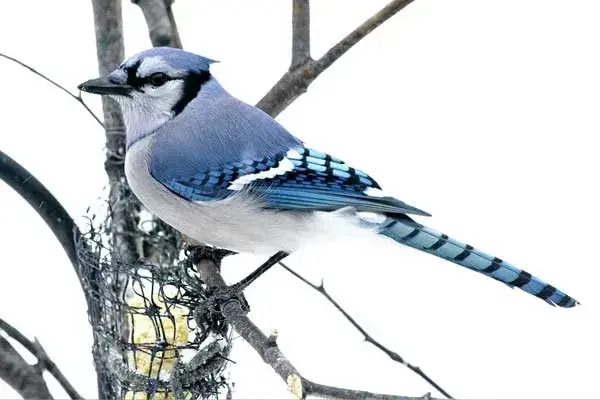
Scientific name: Cyanocitta cristata
Lifespan: 7 years
Wingspan: 13-17 in
One of the largest birds to regularly visit Pennsylvania’s bird feeders, the blue jay is a noisy and aggressive bird that can be seen year-round in western parts of the state.
It is one of the most popular and famous blue birds in Pennsylvania. Look for it near oaks, in forests, woodlots, towns, cities, and parks. It is easy to identify by its noisy calls, large size, and bold colors.
Both sexes have similar plumage – a mix of black, blue, and white plumage above, and white or light gray underneath. On top of the head, there is a large crest.
The blue jay is not a state bird in any US state; it is, however, the mascot of a Major League Baseball team called the Toronto Blue Jays.
These songbirds are very intelligent and can use tools and imitate the sounds of predators.
Blue jays mate for life and work together to build a nest for their young. When the female sits on the eggs, the male will feed and take care of her.
Blue jays are omnivores that mostly feed on seeds, berries, nuts, and occasionally insects. They will often mimic hawk sounds when approaching a feeding site to drive other birds away.
These birds with blue wings are very common in several regions, including Central Texas, North Texas, Central Florida, Maryland, and many others.
Eastern Bluebird

Scientific name: Sialia sialis
Lifespan: 6-10 years
Wingspan: 9-12 in
Eastern bluebirds are summer residents of Western Pennsylvania.
Although some populations might stay year-round in the state, most of those living in western parts will migrate south to winter there. The first to return to Pennsylvania in early March will be the males, going back to the same territories where they previously bred.
You will recognize these beautiful songbirds by their big, rounded heads, large eyes, and alert posture.
Male eastern bluebirds are small North American migratory thrushes with vivid royal blue heads and back plumage and warm red-brown and white breasts. Females have gray plumage above with bluish wings and tails and subdued orange-brown breasts.
Look for them in the open country with scattered trees, farms, and roadsides.
Similar to their cousins, the mountain bluebirds, the eastern bluebirds are cavity nesters that love nest boxes.
They are very social birds living in flocks with over 100 individuals. They are also very territorial.
To attract a female, a male bluebird will sing over 1,000 songs per hour; it sings without opening its beak wide. Listen for their soft melodious warble song and their liquid and musical “turee” or “queedle” call.
These birds are omnivores that mostly feed on insects, including grasshoppers, crickets, beetles, caterpillars, and some fruit.
The Eastern bluebird is the official bird of Missouri and New York.
Indigo Bunting
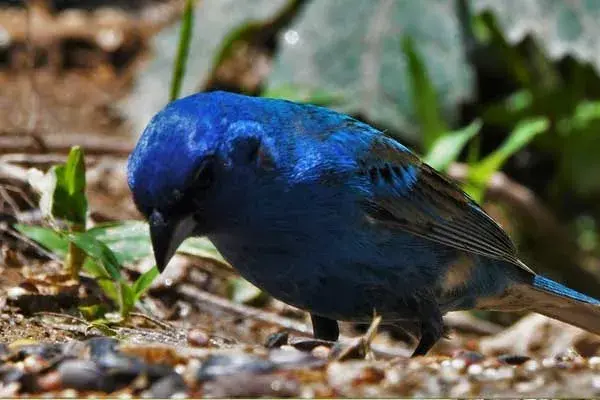
Scientific name: Passerina cyanea
Lifespan: 10 years
Wingspan: 7-9 in
Bright and rich blue, indigo buntings are common during summer in Western Pennsylvania. These small seed-eating birds are also known as blue buntings, due to their plumage color.
In case you decide to look for indigo buntings, look for them in weedy fields and shrubby areas at the edges of woodlands, from spring to fall. Listen for the rapid and excited warble of males singing along every roadside.
Between September and November, indigo buntings will leave western Pa and migrate south, to Mexico, South, and Central America.
These migratory birds prefer to travel during the night, using stars to navigate them.
Adult males have a vibrant blue plumage during summer, with slightly richer blue colors on their heads. During the winter months, they are brown, just like females are year-round.
Indigo buntings are territorial birds and omnivores that feed on insects, seeds, and berries.
These birds usually mate for life; occasionally, they may switch partners within a single breeding season.
A group of buntings is called a “decoration”, “mural”, or a “sacrifice”.
Purple Martin
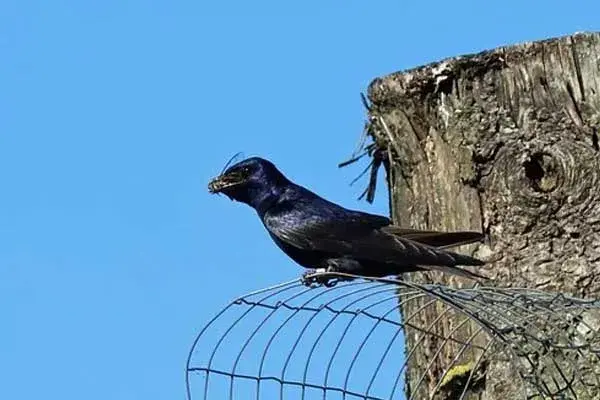
Scientific name: Progne subis
Lifespan: 5-7 years
Wingspan: 15 in
Purple martins can be seen in Western Pennsylvania during summer. They are the largest swallows in North America, known for their chattering song and aerial acrobatics.
After spending winter in the rainforests of Brazil, they will undertake a 7,000-mile-long migration trip back into the eastern United States and Canada.
- Read More: 5 types of loons that can be found in Canada
As a sure sign that spring is close, the first purple martins of the year can be spotted in Pennsylvania around March.
Talking about the appearance, these birds have slightly hooked bills, short and forked tails, and long, tapered wings. Adult males are dark overall with a purplish-blue shimmer visible at close range.
Depending on the light and angle, their head color may appear to be royal blue, navy blue, or deep purple. Females are grayer with shine on the crown and back.
Purple martins will typically build their nests out of straw, twigs, and pine needles. They are very social and colonial birds – the largest roosting colony ever discovered had over 700,000 birds!
Purple martins are carnivores (insectivores) that feed on fire ants, bugs, flies, butterflies, dragonflies, grasshoppers, crickets, moths, wasps, bees, cicadas, spiders, and termites.
They are also excellent fliers that can reach flight speeds of over 40 mph.
Purple martins are also on our list of most common songbirds of Florida.
Barn Swallow

Scientific name: Hirundo rustica
Lifespan: 4 years
Wingspan: 12.5-13.5 in
Barn swallows are summer residents found throughout western Pennsylvania. They are one of the largest swallow species found in the state.
You will identify them by their pointed wings and forked tails that allow speedy flight. They have cobalt blue heads and wings, rusty-orange throats and foreheads, and pale orange chests and undersides.
Males and females look similar – the females’ tails are a little less forked.
Listen for their constant “twitter-warble” song during the breeding season that consists of a long series of continuous warbling sounds and rapid, mechanical-sounding “whirrs.”
In early fall, these long-distance migratory birds fly from North American breeding grounds to Central and South America. Look for them arriving in the state from the middle of April to the beginning of May.
According to legend, the barn swallows got their forked tail because they stole fire from the gods and brought it to people. This made the gods angry so they threw a firebrand at the birds, burning their middle tail feathers.
Barn swallows are insectivores that catch and eat insects in the air as they fly.
Tree Swallow

Scientific name: Tachycineta bicolor
Lifespan: 3 years
Wingspan: 12-14 in
Tree swallows are summer residents of Western Pennsylvania and can be seen there from early March to late August/mid-October.
You will recognize these blue and white birds by their long, pointed wings and short, squared, or slightly notched tails. Pay close attention to these small migratory songbirds that have metallic greenish-blue backs and heads, together with white throats, breasts, and bellies.
Tree swallows are another welcoming sign of spring in much of North America.
They are social animals whose flocks can include thousands of birds.
If you decide to try to identify this species, the best habitats to start your quest will be open spaces such as wetlands or farm fields. Listen for tree swallows’ song, a cheerful series of liquid twitters that consist of three parts: the chirp, the whine, and the gurgle.
They are omnivores that feed on insects, mollusks, spiders, and occasionally on fruit, berries, and seeds.
Read More: 17+ examples of big birds that live in Florida
White-breasted Nuthatch
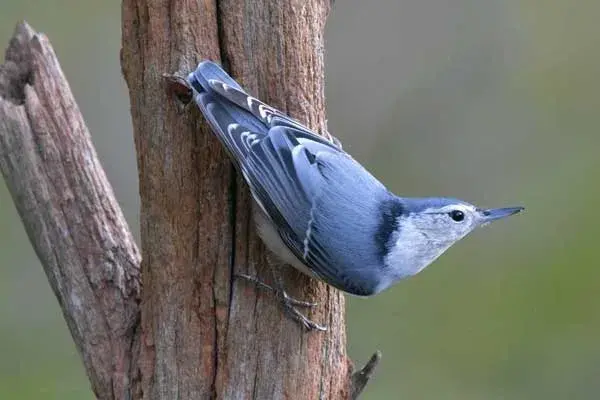
Scientific name: Sitta carolinensis
Lifespan: 2 years
Wingspan: 11 in
White-breasted nuthatches are year-round residents of Western Pennsylvania.
They are the largest nuthatch species in North America and can be identified by their clean blue-gray and white plumage. The male and female look very much alike; the only difference is that the female has lighter color.
White-breasted nuthatches have small tails and almost no neck which makes them look very stocky.
These loud birds got their name from the way they crack open seeds – they will jam their seeds and nuts into tree bark, and then whack it with their beaks to open the seeds.
Common visitors in Pennsylvania, white-breasted nuthatches can be found in forests and open areas in most of the United States and parts of Canada and Mexico.
They are omnivores that feed on insects and seeds.
White-breasted nuthatches often visit backyard bird feeders so if you are lucky to attract them, their quirky personalities will provide you with endless entertainment.
Great Blue Heron

Scientific name: Ardea herodias
Lifespan: 15 years
Wingspan: 5.5 to 6.6 ft
The great blue heron is one of the largest birds of Western Pennsylvania. It can be seen in those parts of the state year-round.
You will easily identify a great blue heron by its large yellow-orange bill, short black plumes on its head, and black and chestnut pattern on the shoulders.
It is quite common near the shores of open water and in wetlands.
During the flight, the great blue heron will hold its neck in an S-shape with legs trailing behind.
Despite their large size and somewhat stocky build, great blue herons are fast birds that can reach speeds of around 30 mph.
They are monogamous only for a single season and will go through some interesting courtship rituals, locking and rubbing their bills on the feathers of the other bird before mating.
Both parents will take turns in incubating the eggs, and after hatching, the chicks can fly at only 2 months of age. They nest in colonies called heronries that can occasionally have more than 500 nests.
Great blue herons are carnivores that feed on fish, amphibians, reptiles, invertebrates, small mammals, and even other birds. These birds will slowly stalk their prey in shallow waters, striking with lightning speed, catching them with their long and sharp beaks.
Belted Kingfisher
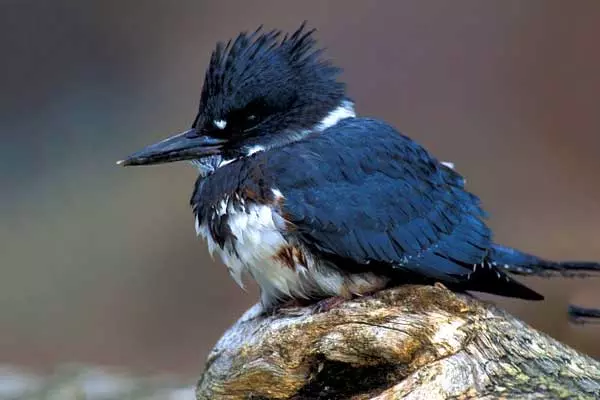
Scientific name: Megaceryle alcyon
Lifespan: 6-14 years
Wingspan: 19-23 in
These large and conspicuous water kingfishers are native to North America.
Belted kingfishers are common throughout the year in western parts of Pennsylvania. They have large heads, shaggy crests on the top and back of their heads, and straight, thick, pointed beaks.
Their upper plumage is blue-gray while the underparts are white. Belted kingfishers have two fused toes which can also help distinguish these blue-winged birds from others.
Belted kingfishers can be often seen around streams, lakes, bays, and coasts.
These birds are also common in Southern California and can be very territorial – males will often charge at and chase intruders away.
If looking for a belted kingfisher, you will hear it before you see it – listen for its distinct and loud rattling or chattering call.
These birds are carnivores that dive to catch fish and crayfish with their heavy beaks.
Belted kingfishers will also eat mollusks, crustaceans, amphibians, and lizards. They can’t digest bones so just like owls, belted kingfishers will regurgitate the undigested pieces as pellets.
Blue-gray Gnatcatcher
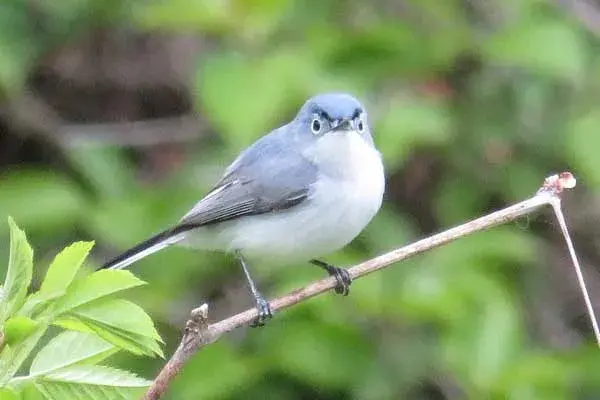
Scientific name: Polioptila caerulea
Lifespan: 3-4 years
Wingspan: 6 in
Blue-gray gnatcatchers are very small songbirds native to North America that can be commonly seen from spring to fall in Western Pennsylvania.
These angry-looking birds will develop dark, V-shaped eyebrow markings during the breeding season that make them look like they are constantly annoyed.
Males have a pale blue-gray color of the heads and the upperparts, and white underparts. Females are less blue, while juveniles are greenish-gray.
In summer, these small birds can be found in open woods, oaks, pines, and thickets.
They are monogamous birds that mate for life. Males can be particularly aggressive and will chase larger birds away from feeding areas or their nesting territory.
Blue-gray gnatcatchers nest in trees and both partners participate in construction. They build their nests from grass, weeds, plant fibers, and strips of bark as the basic material and spider web to bind it all together.
American Goldfinch
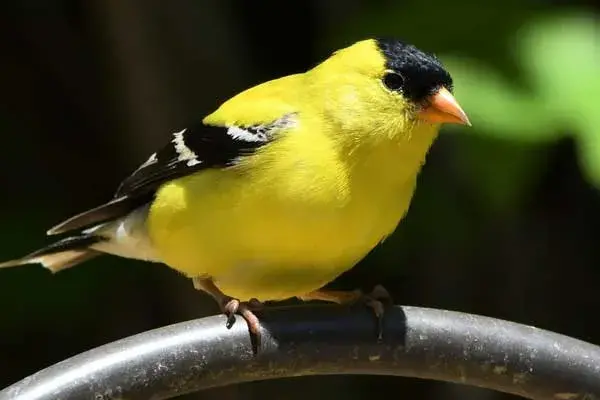
Scientific name: Spinus tristis
Lifespan: 3-6 years
Wingspan: 7.5-8.7 in
The American goldfinch is the state bird of New Jersey, Iowa, and Washington.
This small migratory bird with a small head, long wings, and a short, notched tail can be found in Western Pennsylvania throughout the year.
Look for American goldfinches in a variety of habitats that include brushy areas, roadsides, open woods, woods edges, and suburbs. You might also spot some around bird feeders as goldfinches love to visit them.
They have the nickname “wild canary” because of their bright yellow plumage in the spring and summer. During the winter months, males get an olive color while the females become dull yellow-brown.
American goldfinches molt twice a year, once in late winter and again in late summer.
Male and female American goldfinches have colorful carotenoid-based orange bills during the breeding season. The bill serves as an indicator of the overall health of the bird. The more saturated with orange a bill is, the higher the testosterone levels the bird has.
American goldfinches are herbivores that feed on seeds from many different plants, tree buds, berries, and bird food from feeders.
House Sparrow

Scientific name: Passer domesticus
Lifespan: 3-5 years
Wingspan: 9 in
House sparrows are one of the most widespread and abundant songbirds in the world. They are common backyard birds that are present in western parts of Pa year-round.
These small birds have large gray heads, white cheeks, black bibs, and reddish-brown necks. Males and females look different – females are slightly smaller and mostly buffish above and below.
House sparrows also have very shallow tails with a very small split. Listen for their short and incessant chirping calls that sound like “chirrup,” “tschilp,” or “philip.”
They are very social birds that will often form flocks with other species of birds.
The oldest recorded captive house sparrow lived 23 years.
They feed on grains and seeds, discarded food, and insects.
Northern Cardinal

Scientific name: Cardinalis cardinalis
Lifespan: 3 years
Wingspan: 10-12 in
These beautiful birds with orange bills can be seen year-round in Western Pennsylvania.
Before the 20th century, northern cardinals were uncommon in Pennsylvania.
In the last 100 years, they have expanded their territory and are now found in western parts of the state (among other places), except for heavily forested areas on the Allegheny High Plateau.
Commonly found in woodlands, brushy fields, parks, and other urban areas of the state, these striking birds are also familiar sights in many backyards.
You can easily attract northern cardinals to your bird feeder, especially if you add some sunflower seeds, peanut hearts, millet, or milo.
Northern cardinals are sexually dimorphic – males and females look different.
You will recognize males by their bright red plumage, crests on their heads, and black throats and faces. Females are mostly brown with crests and reddish wings and tails.
They are also known as redbirds and they get their red color from the food they eat – if there are not enough carotenoids in their food, they become brownish.
Listen for their two-or-three-second song which is a loud string of clear down-slurred or two-parted whistles that sound like “cheer cheer,” “birdie birdie,” and “wheet wheet.”
These birds are very territorial and aggressive – northern cardinals will often try to ferociously attack their reflections in the mirrors and windows.
They are omnivores that feed on seeds, fruit, and insects.
In case you notice male cardinals with baldness problems – it’s a sign they’re in the middle of a late summer molt.
These songbirds are also monogamous and mate for life.
Red-eyed Vireo
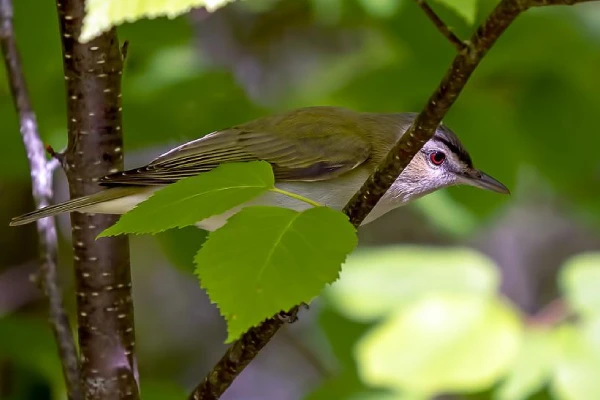
Scientific name: Vireo olivaceus
Lifespan: up to 10 years
Wingspan: 9-10 in
Regularly found during summer in western parts of Pennsylvania, the red-eyed vireo is the most common resident of the state’s forests.
You will recognize this small songbird by mostly olive-green upperparts, white underparts, red eyes, and a grey crown edged with black. Red-eyed vireo also has thick blue-grey legs and a stout beak.
These tireless singers will usually sit high up in the trees and emit different sounds – scientists even recorded one individual singing 117 different song types!
Red-eyed vireos are omnivores and usually feed on insects and berries. Males will feed in the high canopy, while females forage lower down.
They usually breed from mid-April to August and the males are the first to arrive at the breeding grounds in mid-March up to May to establish territories.
After pairing, females will build the nests (males do not help) and lay a clutch of three to five spotted eggs. Both parents will feed the chicks.
These songbirds are susceptible to brood parasitism – in one instance, scientists found one red-eyed vireo female incubating four eggs of other birds; there were no vireo eggs in its nest as the other bird had punctured or pitched out the vireo’s eggs.
Gray Catbird
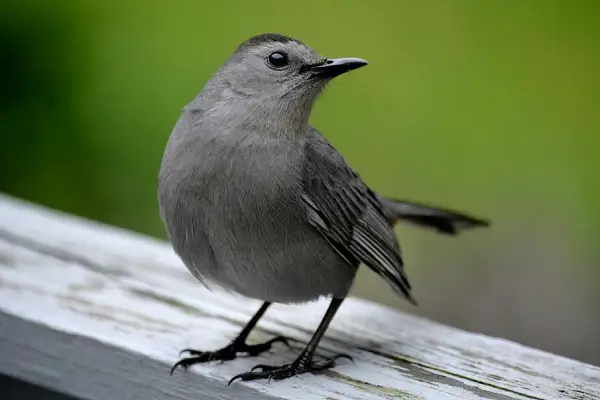
Scientific name: Dumetella carolinensis
Lifespan: up to 17 years
Wingspan: 8.7-11.8 in
Although some populations might stay in other parts of the state year-round, gray catbirds can be seen in Western Pennsylvania only during summer.
You will find these medium-sized songbirds around hedgerows, woods undergrowth, regenerating cut-over land, shrubby areas near water, woods edges, and suburban plantings. Don’t look for gray catbirds in dense forests as they persistently avoid them.
Look for dark gray birds with black caps, beaks, legs, tails, and rufous undertails. Gray catbirds are unmistakable for their cat-like call after which they got their name.
Just like mockingbirds, gray catbirds can mimic the songs of other birds. However, unlike mockingbirds that sing perched on trees, catbirds will often sing from inside a bush or small tree while being hidden by the vegetation.
You might be able to attract them by “pishing” sounds.
These fearless birds are not scared of invaders and will often attack and peck predators that come close to their nests. Gray catbirds will also destroy brood parasitic eggs laid in their nests.
Gray catbirds are monogamous and nest from May into July.
These birds are omnivores and will often forage on the ground. They mostly feed on insects and berries; during summer, their diet consists of 60% of fruit and only 20% in spring.
Downy Woodpecker
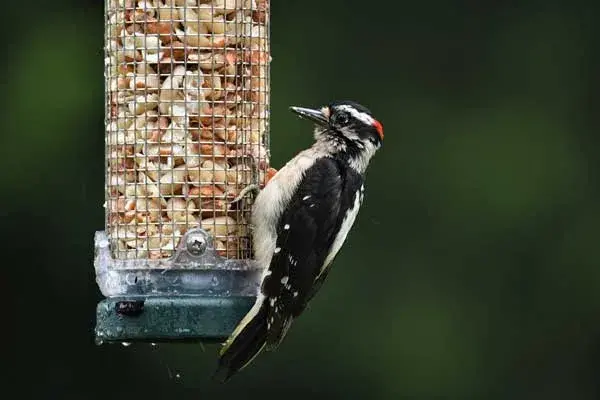
Scientific name: Picoides pubescens
Lifespan: up to 11 years
Wingspan: 10-12 in
The downy woodpecker is the smallest species of woodpecker in Western Pennsylvania. It can be seen throughout the year in the state around open forests of mixed growth, orchards, suburbs, urban woodlots, and parks.
You will identify downy woodpeckers by the black color of their upperparts and wings, white backs, throats, and bellies, and white spottings on their wings. Try to notice the white bar above and below the eyes. Also, adult male downy woodpeckers have red patches on the back of their heads.
Listen for their soft “pik” call and a rattling sound that starts slowly and speeds up at the end, trailing off.
These Western Pennsylvania woodpeckers can hit the tree bark over 10 times per second and have special feathers around their nostrils to save them from breathing in wood chips.
Downy woodpeckers are omnivores that mostly feed on insects, beetle larvae, ants, and caterpillars, but also berries, acorns, and grains.
Look for them around bird feeders, they will often eat suet and black oil sunflower seeds and occasionally drink from hummingbird feeders.
Downy woodpeckers are monogamous and the pair will together prepare a nest in the tree. The female will then lay from 3 to 8 eggs.
Common Goldeneye
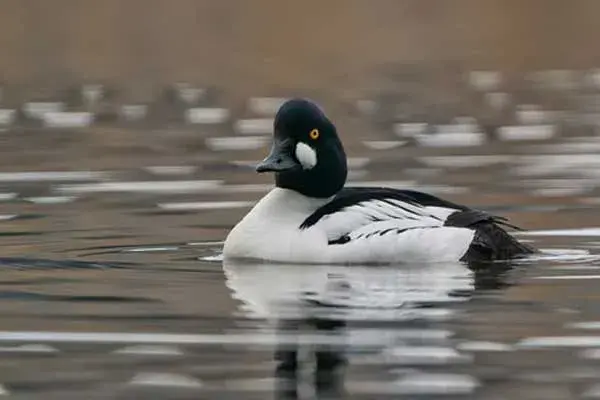
Scientific name: Bucephala clangula
Lifespan: up to 20 years
Wingspan: 30.3-32.7 in
Common goldeneye is a medium-sized duck that can be seen in western Pennsylvania during winter, from late fall to early spring.
You will easily recognize it by its large head and a fairly small and narrow beak.
Common goldeneye has mostly black and white plumage, a dark green head, and a crisp black-and-white body. These birds got their name from their golden-yellow eyes.
In case you decide to look for them, watch for flocks on fairly large bodies of water, their distinctively shaped heads, and the bright yellow eyes that can be seen from afar.
Common goldeneyes are aggressive and territorial ducks that have elaborate courtship rituals.
Males often bend their heads backward to touch their rumps, thrust forward, and kick up water with their feet to seduce a female.
Common goldeneyes are water-diving birds that feed on crustaceans, aquatic insects, and mollusks.
Ring-necked Pheasant

Scientific name: Phasianus colchicus
Lifespan: 3 years in the wild
Wingspan: 22-34 in
The ring-necked pheasant is a large, chicken-like bird that can be seen in western parts of Pennsylvania year-round. It was introduced to the US from Eurasia as a game bird.
You will recognize it by its long, pointed tail, long legs, and neck. Look for it striding across open fields and weedy roadsides.
The ring-necked pheasant, as the name suggests, has a red face, iridescent green head, and a bold white ring around its neck.
To remove dirt, parasites, and old feathers, ring-necked pheasants will often take dust baths.
They are also known for “harem-defense polygyny,” where one male keeps other males away from a small harem of females during the breeding season.
During spring and summer, they will feed on insects, spiders, earthworms, snails, other invertebrates, and some fresh greenery. In fall and winter, they switch to seeds, grasses, roots, fruit, nuts, leaves, and insects when they find them.
The ring-necked pheasant is the state bird of South Dakota.
American Woodcock

Scientific name: Scolopax minor
Lifespan: 2 years
Wingspan: 17-19 in
American woodcocks are summer residents of Western Pennsylvania. You will recognize these short-legged shorebirds by their very long, straight bills, large heads, short necks, and short tails. Their plumage is a mix of browns, grays, and black.
American woodcocks are usually found around wooded or shrubby areas where they can be seen probing the ground in search of earthworms. They also feed on some insect larvae, snails, spiders, beetles, ants, and some seeds.
They are also known as timberdoodles, bogsuckers, and hokumpokes. American woodcocks are popular game birds, with over half a million birds killed annually by hunters.
These birds are most active at dawn and dusk which is a characteristic of crepuscular animals.
Turkey Vulture
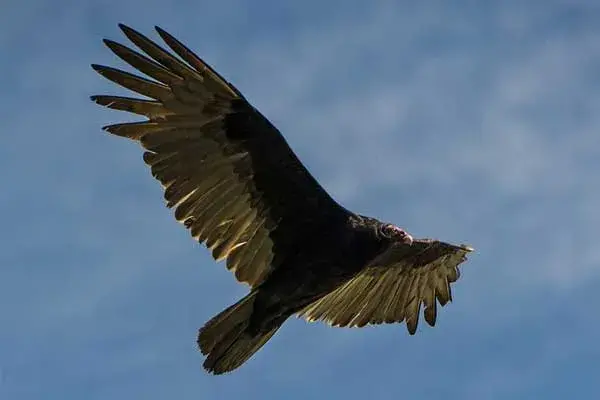
Scientific name: Cathartes aura
Lifespan: 16 years
Wingspan: 63–72 in
The turkey vulture is the largest and most widespread vulture species in Western Pennsylvania. You will find it in this part of the state during summer.
Turkey vulture will migrate into the state around late February and March, breed during summer, and leave from mid-October to mid-November.
The turkey vulture is also known as turkey buzzard (or just buzzard) and got its original name due to its resemblance to a wild turkey.
With a wingspan of around 6 feet, brown plumage, bare red heads, and white legs, turkey vultures are hard to miss in the Pennsylvanian sky.
When they fly, their silvery flight feathers are contrasted with dark wing linings. Thanks to their keen vision and sharp sense of smell, turkey vultures can locate carrion easily.
They lack a syrinx (the vocal organ) which basically makes them voiceless; all turkey vultures can do is hiss, whine, and grunt.
Turkey vultures are bigger than other raptors, except eagles and condors. Some wildlife experts estimate a population of over 18 million turkey vultures in total.
If you decide to go after turkey vultures, look for them in the open areas including mixed farmland, forest, and rangeland.
They are gregarious birds that roost in large community groups with several hundred individuals. You might also spot them sitting in trees on the sides of roads waiting for their next meal.
They do a great service across the US by removing dead animals and preventing the transmission of any diseases those dead animals could have carried.
Because of their extremely strong stomach acids, turkey vultures can eat and digest carcasses tainted with anthrax, tuberculosis, and rabies, without getting sick.
Unlike black vultures, turkey vultures rarely hunt, but might occasionally attack a small snake or mammal.
Bald Eagle

Scientific name: Haliaeetus leucocephalus
Lifespan: 20-30 years
Wingspan: 70.8-90.5 in
Bald eagles are one of the largest birds of prey found in Western Pennsylvania. The best time to see these magnificent birds in these parts of the state is during winter.
IF you go looking for them, remember that they are protected under the Game and Wildlife Code in Pennsylvania, and also by the Bald and Golden Eagle Protection Act and the Migratory Bird Protection Treaty Act.
In the 1980s, there were only three pairs in the state. Due to strong conservation efforts, there are now more than 300 nests there.
Bald eagles are common around lakes, reservoirs, rivers, and some rangelands and coastal wetlands where they can catch and scavenge fish.
You will recognize them by their commanding presence, white heads and tails, brown color, and bright yellow bills.
Before attaining these characteristics around the age of five, bald eagles are mostly dark brown with varying amounts of white mottling.
They build the largest nests of any North American bird that can be up to 13 ft deep and 8.2 ft wide.
These magnificent raptors are hard to miss as they soar through the air with their 7.5-foot-wide wingspan.
They are carnivores and opportunistic feeders that mostly consume fish, which they snatch from the water with their sharp talons.
Bald eagles are also one of the largest birds found in Ohio, Michigan, and Florida.
Barred Owl
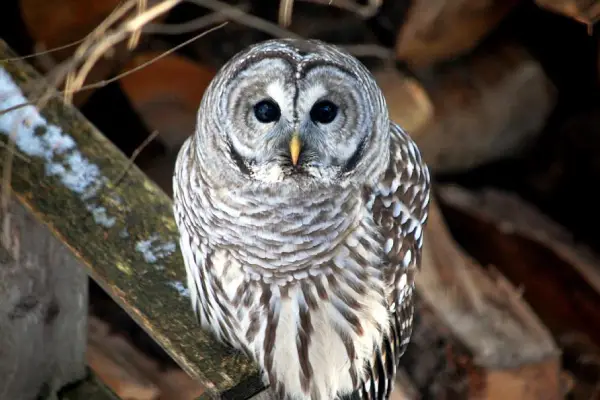
Scientific name: Strix varia
Lifespan: 10 years
Wingspan: 38-49 in
The barred owl is commonly found in Western Pennsylvania year-round, mostly around forest swamps, riparian forests, and upland forest habitats. It is known as the northern barred owl, striped owl, and hoot owl.
You will recognize a barred owl by its mottled brown plumage, yellow beak, dark eyes, and the absence of ear tufts.
Barred owls are also known for their calls that can be heard almost half a mile away. Listen for their accented hoots that sound like “who cooks for you, who cooks for you all.” You will mostly hear these birds in Pennsylvania early in the night, at dawn, and occasionally on cloudy days.
Barred owls have a sedentary nature, they do not like to migrate much.
They are carnivores that mostly hunt at night and feed on some insects, small mammals, and even crayfish and crabs.
Barred owls mate for life and nest in hollow trees.
They are also one of many birds found in Northeast Ohio.
Great Horned Owl

Scientific name: Bubo virginianus
Lifespan: 15-25 years
Wingspan: 35.8-60.2 in
Great horned owls are the largest owl species in the state and can be seen year-round in Western Pennsylvania. They are almost two feet long, have a wingspan of almost 5 feet, and can weigh up to 3.5 pounds.
Great horned owls are widespread and can be found in mountains, grasslands, conifer forests, deserts, chaparrals, and many other habitats.
They have one of the most diverse diets of all North American raptors and feed on rabbits, hares, rats, mice, voles, other small mammals, larger mid-sized mammals, reptiles, amphibians, and invertebrates.
Just like the barred owl, it relies on its acute hearing and excellent eyesight to locate the prey. To catch the unsuspecting animal, this owl will fly in near silence.
In case you see a great horned owl in person, you will notice long, earlike tufts, intimidating yellow eyes, and a deep hooting call. It has a gray-brown plumage with a mottled pattern and a white patch at the throat.
Listen for their call that consists of five deep, booming, uninflected hoots “hoo-hoohoo hoo.”
Great Horned Owl Call | Source: Michael & Katie LaTour, CC BY-SA 4.0, via Wikimedia Commons
Great horned owls are monogamous birds and may stay together for over five years, sometimes even for a lifetime. They are one of the earliest nesting birds in North America and will often lay eggs weeks or even months before other raptors.
These owls are also one of many animals that become active at night in PA.
American Kestrel

Scientific name: Falco sparverius
Lifespan: 5 years in the wild
Wingspan: 20-24 in
American kestrels are the smallest North American raptors found in Western Pennsylvania. They are also known as sparrow hawks and can be seen throughout the year in the state.
American kestrels can be often seen in the open country including farmland, orchards, and grasslands, looking for grasshoppers, rodents such as mice, shrews and voles, and even small birds.
Males and females look different – they are a sexually dimorphic species. Males have red, white, and blue plumage with white underparts, bluish wings with white spots, blue heads, and brown-red backs.
Females are slightly larger and have rufous wings and backs with dark brown barrings, brown speckled or streaked creamy white underparts, and red-brown tails.
American kestrels have three basic vocalizations – the “klee” or “killy“, the “whine“, and the “chitter“.
Depending on the plumage, size, and vocalizations, there are 17 subspecies of American kestrel.
American kestrels are cavity nesters that might occasionally nest in woodpecker holes or abandoned nests of other birds.
Due to the loss of habitat, their numbers have decreased significantly, around 50% between 1966 and 2015.
One of the ways you can help is to provide nest boxes in suitable kestrel habitats across Western Pennsylvania (and other parts of the US).
Read More: List of birds in Eastern Tennessee
Summary
This concludes our list of birds in Western Pennsylvania.
There are several types of birds found in Western PA, including many types of songbirds, raptors, woodpeckers, owls, ducks, and many others.
Next time you see any of these birds in person, you should be able to recognize them with ease!
And if you enjoyed our article, here are our other popular reads on birds: 25+ common birds found in Northern California and 15+ examples of green birds in Florida